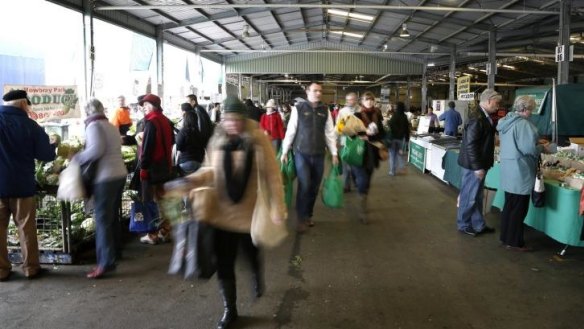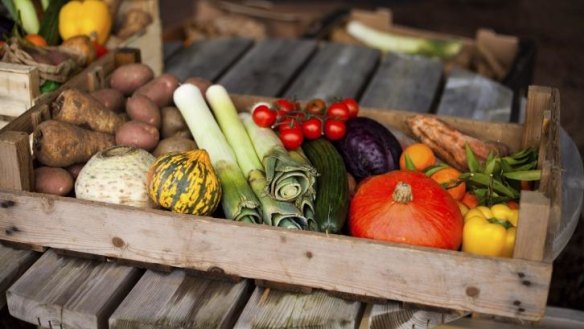How I spent a year without shopping at Coles or Woolworths

I don't much get into New Year's resolutions, but this time last year a friend of mine, a Canberra comedian, suggested I resolve to not spend a single dollar at Coles or Woolworths for the entire year. While he was half joking, given my view of the practices of these two monolithic stores, and my food ethics, it was a challenge I wanted to accept.
The greenhouse emissions of the transport system that takes fresh food and other grocery items from their country or place of origin, to a wholesale market, to a warehouse, trucked to a grocery store, and sometimes on to a second or third store are huge. Products crisscross the country, and sometimes the world. If you try to buy a locally grown mango in Darwin, it will have been shipped to the wholesale market in Brisbane, before being trucked all the way back to Darwin for retail sale. Then there's the food miles of importing foods like garlic (commonly imported from China), lemons (often from the United States or asparagus (from Peru) into that system for them to be bought to you in the off season. On top of that, there's the hydroflurocarbons (HFCs) and hydrochloroflurocarbons (HCFCs) used in the refrigeration of all that food throughout its journey. Many of these chemicals are potent greenhouse gases. HCFCs also deplete the ozone layer. HCFC-22 is the most common refrigerant in Australia.
I also have social concerns with both businesses. Farmers have been complaining about unfair prices for produce, and unreasonable contract requirements for years. The $2 milk wars were a very visual example of some of these practices, but similar complaints have been made by vegetable producers including those producing potatoes and onions.

Indeed, in 2013, the Australian Competition and Consumer Commission undertook an investigation of the major supermarkets. It's not that I haven't set foot in a supermarket at all - just not the big two. In Canberra, we are lucky to have a third supermarket chain, Supabarn, but the stores are entirely out of my way. So I purchased very little from them during the year. Perhaps I would visit every six to eight weeks and stock up on my favourite chocolate or some household items like cleaning products or shampoo. I shop at my local IGA relatively regularly though. The stores are always stocked with items that are reflective of the locals and the owners, providing a community feel that I prefer to the nationwide grocery chains.
While IGA still has some power of collective purchasing, stores have more flexibility to buy from local suppliers and don't have the same power to force unreasonable expectations on suppliers.
Before the year began, I bought the majority of my fresh food from my local farmers' market. This resolution meant that I needed to better plan my food needs so I didn't need to dash to the shop for just that one thing to make dinner complete.
The market is a mostly cash-only zone, so I go with my $50 and get my food for the week. I know the name of the person who produced every item in my market bag each week and that's a great feeling. It is the polar opposite of the Woolworths/Coles shopping experience.
Canberrans are lucky to have a good-quality farmers market in town on such a regular basis. I believe weekly farmers markets are the best way to change people's shopping behaviour – the regularity means there is a viable shopping alternative that can be relatively easily incorporated into a routine.
A monthly market does not provide a serious alternative for daily food items.
I urge market organisers, and communities considering the beginning of a farmers' market to plan for a weekly market, containing as much locally produced food as shoppers would reasonably consume within the seasons. The Capital Region Farmers Market is a great example of this – organisers take great effort to get a good variety of produce so that it is possible for shoppers to buy all their food there each week. Still, this does not mean that everything on offer at the supermarket is available at the farmers market, but with due consideration of seasonality and what grows in the region, you can easily buy food for a balanced, healthy diet.
Here are the places I shopped:
Protein
I buy my eggs, milk, poultry, pork, beef and fish at the Capital Region Farmers Market. There is also a lady there who sells amazing tofu that she makes in Belconnen. Occasionally I buy some tofu puffs, silken or firm tofu from her. It is by far the best tofu available in town. If a craving for tempeh comes to me, I buy it from the local food co-op in town, this has been my only exception to buying protein at the market.
Milk and cheese come from the lovely folks at Tilba, who bottle their own delicious Jersey milk and make a very fine aged cheddar. Sometimes I buy goat cheese from Leaning Oak, and other specialty cheeses from Small Cow Farm. Eggs are from Sam at Holbrook Paddock Eggs. It's a family business producing free-range eggs of the highest possible quality. Indeed, the eggs have won gold medals at both the Melbourne and Sydney Fine Food Awards in the past two years.
For free-range chicken, occasionally duck, and at Christmas a turkey or goose, I go to Thirlmere Poultry whose farm is outside Canberra.
Beef comes from a very small farm based just outside Batlow. Gilmore Braes raise heritage beef cattle that have excellent flavour, in happy conditions. Once a beast is slaughtered it is sold nose to tail.
All of my pork products I get from Boxgum Grazing, who now make excellent bacon. Their fresh meat is of the highest quality, and comes from happy pigs who I have visited on their free-range farm.
I buy my fresh seafood from Hayley at Narooma Seafood. Her family owns the boat, catches the fish and brings it to market for me to buy. It's great fish, caught locally, just off the coast. I also sometimes get smoked or cured fish from Ann, at Cypress Valley. Her smoked trout is to die for, and I do love her gravlax. Sometimes I'll buy some of her other smoked goods – I'm particularly fond of her smoked baby octopus.
Fruit, vegetables and other greens
Most of my fruit, vegies and other greens comes from the farmers' market. These include staples such as garlic (when it's in season), onions and potatoes. I buy brassicas, root vegetables and other green things as they come into season in autumn, winter and spring respectively. These vegetables come an average of 200 kilometres to Canberra, but many are grown right here around town. I buy some salad greens at market too, but come spring and summer I do a lot of foraging, picking wild greens and edible weeds to add to salads and stir fries.
I buy locally grown berries and cherries from various market stalls too. I also do a fair amount of urban foraging for fruit to eat and preserve. Canberra is blessed to have streets deliberately planted with fruit-producing trees. Soon enough, community initiatives like the Lyneham Commons will also be bearing fruit.
Dry goods
I mostly get my flour, nuts and dried beans from the Food Co-Op Shop in Acton. The prices are very reasonable, the range is quite extensive and there are a lot of organic options. The co-op is on my bike ride from home to my office. I take the clear cubes and reusable tins into the store and weigh the containers before filling them up. If you volunteer your time once a month, you get a reasonable discount on your shopping items. They have a good supply of other local fresh produce including fruit and vegies, vegan cheeses, tofu and fermented foods.
Sticking to the resolution meant planning my meals better, to prevent those last-minute trips to the shops to get that one (or two) things to make dinner complete. It meant I could only really do one food shop a week. A Saturday morning market trip is my routine, rain hail or shine. I have figured out pretty much exactly how much milk I drink a week in summer and winter. As for dry goods, I was frustrated at myself on more than one occasion for not remembering to bring the flour tin, to fill at the co-op on my way home from the office. Perhaps that's a similar frustration for Canberrans who forget to take their green bags to the supermarket. Over the years I have learned to make my high- quality market food go further with some thrifty tips to keep the shopping on budget. For example, I buy whole poultry and cut it into portions myself. I save my veggie tops and bottoms and use them to make stock from the poultry carcass. Overall, I get to eat extremely well, on a limited budget, buying into an economic system we can all be proud of. In reality, I don't miss the bright lights, poor customer service and bad shopping behaviour at Woolies, and I've found that over the past year, absence has not made the heart grow fonder, only more aware of what I missed out on.
I love that I support the producers who are working in agriculture the way I want our food systems to operate.
Will you give it a go this coming new year? Can you do a year without Coles and Woolworths? I would not be surprised if you find it as enjoyable as I did.
Restaurant reviews, news and the hottest openings served to your inbox.
Sign up